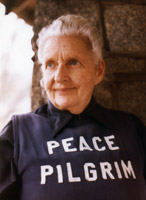Peace Pilgrim: Her Inspiring Legacy
I must say it’s disconcerting to walk into stores and see clothes that look so much like those I wore in my younger years. Fortunately most of them are pretty unattractive and are clothes I would never wear again even if I could.
On the other hand, they bring back memories of an era and a generation that staged protests and raised their voices in an endeavor to make the world a better place.
I like that I often see that same desire in today’s youth.
While my generation may like to think they invented the concept of social action, not to mention the colour combination of brown and orange, a colleague once told me the remarkable story of a relatively unknown activist who predated the flower children by several decades.
Some sixty years ago a forty four year old American woman, Mildred Lisette Norman Ryder, known by most as Peace Pilgrim, initiated her first cross-country walk for peace.

She walked on her own, penniless, her only possessions – a toothbrush, comb, pen, and later, her pamphlets, carried in the pockets of a tunic she wore that had Peace Pilgrim painted on the front and Walking Coast to Coast for Peace on the back.
She walked until someone offered her shelter or food. Most often she was given both but she sometimes slept in fields or missed meals.
Her message along the way was a simple one: overcome evil with good, hatred with love, and falsehood with truth. Her definition of peace included peace among nations, among people and individuals, and the most important peace, peace within oneself.
Setting out she carried three petitions - one was to end the war in Korea, the second to establish a U.S. Peace Department, and a third petition directed at the United Nations, urging world disarmament and the redirection of arms spending toward funding for human needs.
She delivered all three upon her arrival on the east coast eleven months later.
Throughout her journeys that spanned almost three decades, she never approached anyone, waiting for people to approach her. When they did, she talked tirelessly.
For those who asked, she gave out her Steps Toward Inner Peace pamphlet.
She had a magnetism that was instantly felt and became a spellbinding, forceful speaker with a consistent message that included powerful stories and inspiring one-liners that were easy for people to understand, apply, and remember.
She claimed people needed two things in life for life to be meaningful. Something to lift them up spiritually and inspire them to awaken to their higher nature such as religion, art, or nature, and, a calling, a path of service, or something to do that would help someone else because, in this world, she said, “You are given as you give.”
Her message was a personal one, directed at the individual, and delivered in a simple, understandable way, one-on-one. Her brilliance was in a message and a manner of delivery that changed people, one person at a time, to empower and release their individual potential.
And that perhaps is the most important lesson – everyone can make a difference.
Peace Pilgrim wasn’t all that different from anyone else. She grew up on a small farm in a loving family. She was at one point married, albeit not happily. Throughout her life she searched diligently for the service she felt she was called to undertake, working with senior citizens, those with emotional problems, and volunteering with peace organizations.
Prior to her pilgrimage, she simplified her life getting rid of unnecessary possessions and activities. She took up hiking to increase her physical strength and as a way to experience and appreciate the freedom of simplicity.
Through trial and error Peace worked out her own steps to inner peace, walking daily, appreciating nature, and putting into practice the inspirations that came to her. After she had attained inner peace she had a compulsion to share it. That became the impetus for what became a pilgrimage of almost thirty years.
She walked until July 7, 1981 when she was struck by an oncoming car that crossed the median. She died shortly thereafter as perhaps one of the most underrated and least known spiritual leaders and peace activists of our time.
What was her legacy?
Perhaps the greatest testament to her influence is that her story, teachings, and writings have endured and continue to be distributed long after her death mostly now via a website at http://www.peacepilgrim.org. Her message continues to be shared.
Posted on 07-04-15Next entry: Small Town Advantage
Previous entry: Born to Dance?

 Brenda Herchmer is the owner of Grassroots Enterprises, a community development consulting company.
Brenda Herchmer is the owner of Grassroots Enterprises, a community development consulting company.